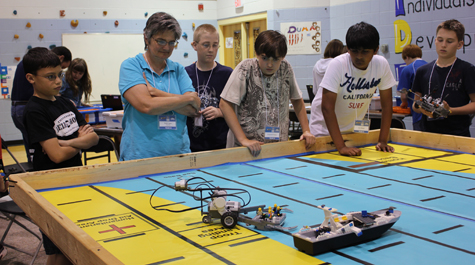William & Mary receives $2.5 million for STEM education
The College of William and Mary has received a sole-source contract from the Department of Defense for a total of $2.5 million over three years. The first year of the contract is underway, funding science, technology, engineering and math (STEM) outreach and training for Naval scientists and engineers who volunteer in school divisions.
“There are exciting things happening with this new grant,” said Gail Hardinge, executive director of the STEM Education Alliance at the William & Mary School of Education.
The alliance pairs teachers with professional engineers and scientists from the defense department, allowing them to co-teach in STEM classes. The alliance also provides scientists and engineers with educational climate and ethics training and strategies to enhance STEM career awareness. Since it began in 2004 as the Virginia Demonstration Project, the alliance has worked with more than 19,000 students in seven school districts and engineers from four Naval commands. This summer, the alliance ran four summer academies with over 300 students and approximately 75 teachers.
{{youtube:medium:left|98LrNNeaWlU}}
“I am delighted that the STEM Education Alliance will be able to continue and expand its excellent work with the help of this grant,” said Virginia McLaughlin, dean of the School of Education. “The alliance plays an important role in advocating STEM careers among today’s youth and preparing them to become tomorrow’s leading scientists and engineers.”
The new grant will allow the alliance to expand its reach. The alliance will now be able to offer follow-up training to scientists, engineers and teachers online. In the past, staff members had to travel to schools to conduct follow-up training.
“We will provide a combination of face-to-face and distance training, and we’re developing online modules for the Department of Defense,” said Hardinge. “Our goal is to broaden the reach beyond the labs. For example, it’s very costly for us to conduct all follow-up trainings, and the bigger we become, the more demand there is to have face-to-face. So, what we’re going to do is combine initial face-to-face sessions with follow-up distance sessions, and they’ll be synchronous. So, we’ll provide synchronous and asynchronous training.”
Jake Joseph, the project’s assistant director, will direct the alliance’s first pilot synchronous training this fall with the Navy’s Space and Naval Warfare Systems Command in Charleston, S.C. The upcoming session is a follow-up to training the Alliance did for the group in Charleston in July.
In addition to creating distance learning opportunities, the new contract will also fund the publication of a second edition of the Alliance’s magazine, “Explore.”
“The first magazine focused on college careers only,” said Hardinge. “As we’ve become more familiar with the career and technical needs of our community and beyond, we recognize the need for a second edition of the magazine to explore skilled labor through college.”
The contract will also allow the alliance to support a Hampton Roads Regional STEM Coalition, which will partner with local teachers, engineers and scientists. In addition, the contract is funding an expansion of the alliance’s use of the STEM Attitude and Awareness Scale, which assesses students’ knowledge of and attitudes toward science, technology, engineering and math.
“We’ve used our evaluation instrument in Virginia on over 5,000 students,” said Hardinge. “We are now contracted to evaluate Charleston, South Carolina’s STEM programs.”
For more information on the STEM Education Alliance, visit http://education.wm.edu/ourfacultystaff/grants/va_demonstration_proj/index.php.

















